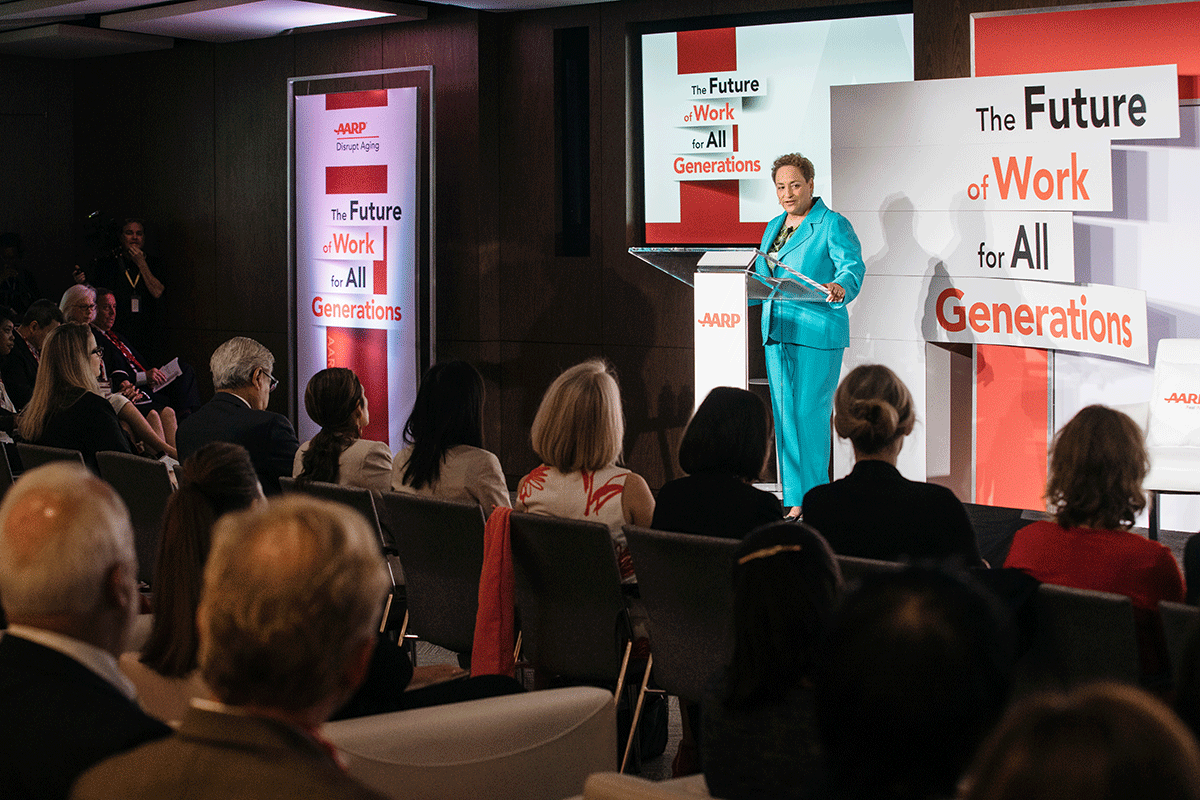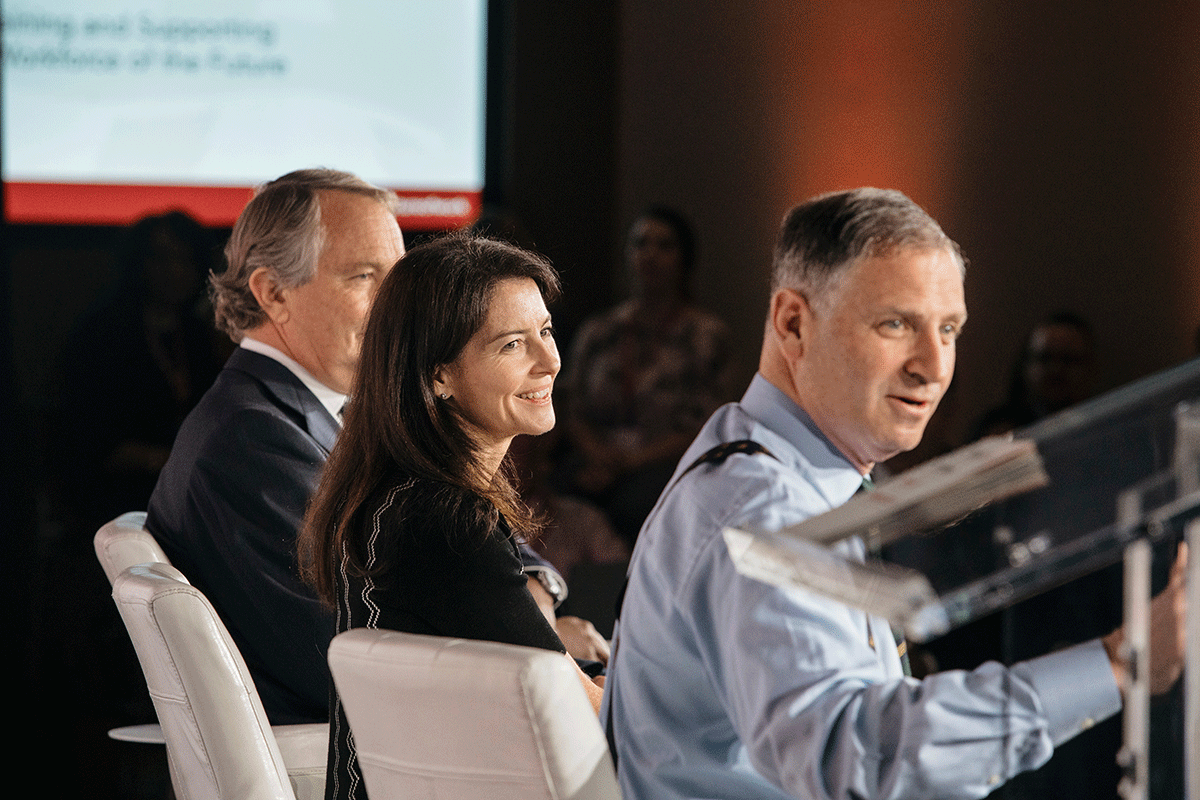“Disrupt Aging: The Future of Work for All Generations”
Historic event conveys the business imperative of fostering an age-diverse workforce and sends out a call to action.
WASHINGTON, D.C. – With populations aging at historic levels in nations across the globe, an age-inclusive workforce is both a societal and business imperative.
That message reverberated throughout a landmark gathering at AARP Headquarters of executives from some of the world’s most prominent companies and other organizations. The event, called “Disrupt Aging: The Future of Work for All Generations,” was the first-ever global conference to tackle the issue.
By day’s end, participants left with an encompassing takeaway—one underpinned by dynamic summit discussions that offered detailed information, countless ideas for immediate application, and calls to action for effecting both change and shifts in thinking.
That takeaway: Leaders from all sectors must intentionally create “The Future of Work”—and they must start doing so now.
That is because, as AARP CEO Jo Ann Jenkins highlighted in her opening remarks that kicked off the event, the world is undergoing unprecedented demographic change. By 2050, 62 countries—including China and its 1 billion-plus people—will have at least 30 percent of their populations in the 60-and-older age segment. Today only one country, Japan, has reached that milestone. In the U.S. alone, 10,000 people turn 65 every day.
As part of the aging trend, life expectancies are increasing. For many people, that means more years past traditional retirement age to not only sustain oneself financially but to contribute—to society, to the economy, and more. Jenkins noted that traditionally, aging has meant an opportunity to achieve freedom from work. Today and going forward, however, “One of the things we’re finding at AARP is that freedom to work is so important,” said Jenkins. “People want or need to work.”
A Business Imperative
 Business leaders and experts featured at the summit said the implications of the aging trend span from employer to employee, from company to customer. Regarding the latter, businesses’ customer base has already begun to shift to older age segments, and those segments will represent their key revenue streams going forward. In the U.S., the 111 million people who are age 50 and over already fuel $7.6 trillion in annual economic activity. That figure is set to increase to $13.5 trillion by 2032, in just 13 years.
Business leaders and experts featured at the summit said the implications of the aging trend span from employer to employee, from company to customer. Regarding the latter, businesses’ customer base has already begun to shift to older age segments, and those segments will represent their key revenue streams going forward. In the U.S., the 111 million people who are age 50 and over already fuel $7.6 trillion in annual economic activity. That figure is set to increase to $13.5 trillion by 2032, in just 13 years.
With a fundamental principle of business being that a company must understand its customers, the implication is clear: organizations need to hire talent reflective of their customer base. It’s the same intuitive principle and business case that has driven diversity & inclusion initiatives—yet, experts said at the conference, today only 8 percent of such programs include age.
Thus, building a diverse staff is a must, even a no-brainer, panelists said. “If you want to build an innovative company, I don’t know another way to go about that,” said Porter Braswell, CEO and cofounder of Jopwell.
Getting a diversity of perspectives in the room is an approach embraced by former Secretary of State Madeleine Albright, the summit’s featured speaker, who discussed her career and views on the future of work in a fireside chat with William Lewis, CEO of Dow Jones & Co., and publisher at The Wall Street Journal. The discussion, in fact, highlighted how Albright herself is the very personification of the future of work—a future (and present) in which work can include many chapters and even careers. Her storied career continues to this day with dynamism, in the form of her recent book Fascism: A Warning, her work at global strategy firm Albright Stonebridge Group and investment advisory firm Albright Capital Management LLC, and other endeavors. Albright’s career exemplifies what speaker Diana Wu David, author of Future Proof: Reinventing Work in an Age of Acceleration, called “the new normal”—that is, workers “reinventing themselves” many times over.
Regarding workplace age diversity, Albright was characteristically direct. “You can’t possibly know everything yourself,” she said. Thus, she urged, “Make cross-generational work the mode of the day.”
Albright also garnered some laughs via her insights on the topic. “I’m a perennial,” she said, riffing on the name for a certain younger generation, “and I think perennials mix pretty well with millennials.”
Another intuitive business principle is for organizations to make their talent pools as large as possible. With the talent pool aging, overlooking older workers could be a huge mistake. Simply put, “It’s an enormous waste of talent,” said Alex Wynaendts, CEO of the global life insurance and financial giant Aegon.
Intention and Action
 How do you tap the opportunity within the five-generation workforce? Employers, said summit speakers, must be intentional about achieving age diversity. Organizations must be inclusive, and not just during the hiring but at the very core of its culture. “If you don’t create a sense of belonging, then [any given staff member is] not going to feel comfortable contributing,” said Morgan Stanley Global Head of Talent Management Peg Sullivan.
How do you tap the opportunity within the five-generation workforce? Employers, said summit speakers, must be intentional about achieving age diversity. Organizations must be inclusive, and not just during the hiring but at the very core of its culture. “If you don’t create a sense of belonging, then [any given staff member is] not going to feel comfortable contributing,” said Morgan Stanley Global Head of Talent Management Peg Sullivan.
One way to foster intergenerational collaboration, panelists said, is through mentorships and reverse mentorships—either with formal programs or by fostering the concept of mentoring in the organizational culture.
Morgan Stanley has successfully expanded its talent pool through a return-to-work program. The program initially grew out of the desire to attract more women, but Sullivan now sees it as a means of attracting workers of different generations. Sullivan said that “the impact has been fantastic,” with hundreds of recruits from the program infusing added enthusiasm and unique experiences into the company.
Other policies that attract and keep older workers, meanwhile, are key. In many cases, such policies involve flexibility. Underscoring the need to invest in workers of all ages, AARP Chief Public Policy Officer Debra Whitman gave one example: “Today, more than 20 million employees are struggling with two full time jobs—inside the home as caring for a family member or friend, and outside the home to earn a living.” She alluded to the comments of speaker Jeff Huber, CEO of Home Instead, who discussed how policies that support caregivers (e.g., with paid leave to meet caregiving needs), support all generations of workers.
With the extended careers (and even new careers) becoming the norm, speakers also discussed the importance of education and reskilling. Given that change is a constant in today’s business environment, Julio Portalatin, vice-chair at Marsh & McLennan Companies, rejected the word training for its outdated connotation, calling the term “episodic.”
That’s not the only term that may be outdated. As 100-year lives become more common, “You do have to retire the word retirement,” said Portalatin.
Only the Beginning
In her closing remarks, Whitman urged employers to move forward, conveying that such action is in the interest of all—including them. “To gain the benefits of age diversity, employers must create a culture that supports all generations in the workforce,” she said.
The summit was far from being a one-off event. It marked the U.S. launch of a new global two-year initiative behind which is a formidable group of organizations. Driving the learning collaborative, called “Living, Learning and Earning Longer” is the World Economic Forum, working in collaboration with AARP and the Organization for Economic Cooperation and Development (OECD).
Continually throughout the experience, speakers challenged their executive-level peer participants to take the day’s wealth of information, insights and messages and incorporate them into their work—and, perhaps most importantly, infuse the value of age diversity into the very culture of their organizations.
The participating companies and other organizations, in fact, walked away from the summit with concrete opportunities to take action. Employers and knowledge partners (whether they attended or not) can engage with the learning collaborative through regional workshops, webinars, peer learning conference calls, site visits, and a range of other means. Organizations are also encouraged to take such actions as sign an AARP Employer Pledge committing to age diversity & inclusion and adding age to their diversity & inclusion policies and initiatives.
“Let me be clear,” Whitman said, “developing an age-diverse workforce is not about charity. Employers that take the right steps will be rewarded in the marketplace. They will enjoy a competitive advantage, based on better performance in many ways.”
For more information on the “Living, Learning and Earning Longer” initiative, contact Jeff Gullo at AARP or go to www.aarpinternational.org/llel.